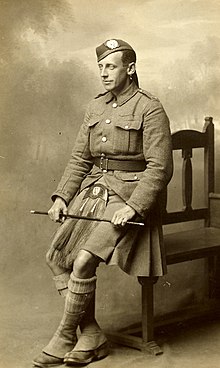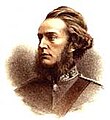London Scottish (regiment)
| A (The London Scottish) Company | |
|---|---|
London Regiment | |
| Garrison/HQ | 59 Buckingham Gate (1886–1985)[1] Horseferry Road drill hall (1985–2017) 76D Rochester Row (2017–present) |
| Nickname(s) | Cockney Jocks (Piccadilly Allsorts) (Duke of Bangkok's Rifles) |
| Motto(s) | Strike Sure |
| March | Highland Laddie |
| Anniversaries | 31 October 1914. First TA unit into action in WWI, Messines Ridge, 1st Battle of Ypres |
| Commanders | |
| Honorary Regimental Colonel | Lord Geidt GCB GCVO OBE QSO PC |
| Colonel of the Regiment | Air Vice-Marshal Ranald Torquil Ian Munro CBE TD VR[2] |
| Insignia | |
| Tartan | Hodden Grey |


The London Scottish was a
History


Formation
The regiment was founded on the formation of the
First World War
The 1/14th Battalion was mobilized on the outbreak of war, departing for France on 15 September 1914. On 31 October 1914 the battalion encountered German forces at Messines in Belgium, the first territorial unit to do so – a memorial stands on the site.[8] The 2/14th Battalion embarked for France in June 1916 but was then transferred to Salonika and Palestine.[8]
Inter-war
In 1937, on the break-up of the London Regiment, the unit was re-named The London Scottish, The Gordon Highlanders.[7]
Second World War
The London Scottish raised three battalions during the Second World War, two of which served overseas. Both of the overseas battalions served with the Middle Eastern Forces in Sicily and Italy. The battalions were:
1st Battalion
The peacetime battalion of the regiment, served as infantry within the
2nd Battalion
Raised as a 'duplicate' of the 1st Battalion, with a core of officers and senior NCOs from that battalion. The battalion initially served in the 141st (London) Infantry Brigade, 47th (London) Infantry Division.[10]
3rd Battalion
When the duplicate battalion was formed in April 1939, the regiment had enough recruits to form a third battalion; permission was granted provided it was formed as an anti-aircraft (AA) regiment of the
Post-war
In 1967 the London Scottish tradition was resurrected on the formation of G (London Scottish) Company 1st Battalion
London Scottish Cadet Corps
The London Scottish Cadet Corps, which was formed around 1902, had three companies, a pipe band and its own colours and was sponsored by the regiment.[22] The corps evolved to become 235 Westminster Detachment (London Scottish Regiment), part of 23 Company Middlesex and North West London Army Cadet Force: it is based at the Rochester Row Army Reserve Centre in Westminster and alongside 102 (Bromley), and 95 (Southwark) detachments (Part of South East London Army Cadet Force) are the sole surviving cadet units maintaining the traditions of the regiment.[23]
Uniforms

From its establishment in 1859 The London Scottish wore

Regimental Pipes and Drums

Being founded right after the regiment was raised, the Regimental
From 1953 to 2002, the Pipe Major of the London Scottish held the position of Piper to the Queen Mother.[29]
Alliances
 The Toronto Scottish Regiment (Queen Elizabeth The Queen Mother's Own)
The Toronto Scottish Regiment (Queen Elizabeth The Queen Mother's Own)
Victoria Crosses
Three members of the regiment were awarded the Victoria Cross:
- Charles William Train; Palestine, 1917.
- Robert Edward Cruickshank; Palestine, 1918.
- George Allan Mitchell; Italy, 1944.
Commanders
- 1859–1876: Lieutenant-Colonel Lord Elcho
- 1894–1902: Lieutenant-Colonel Eustace Balfour
- 1902– ? : Lieutenant-Colonel W. E. Edmonstone Montgomerie[30][31]
Memorials
The unit's First World War and Second World War memorials are located in the Drill Hall at London Scottish House, 95 Horseferry Road in Westminster.[32]
-
Detail of the Messines memorial
-
Detail of the Messines memorial
-
Detail of the Messines memorial
Gallery
-
Lord Elcho
-
Bromsgrove Cemetery, gravestone of 2nd Lieutenant R.D. Cotton MC
References
- ^ "London Scottish Regiment H.Q." Plaques of London. Retrieved 28 May 2017.
- ^ "About the band". London Scottish. Retrieved 24 August 2021.
- ^ "Minutes of an Annual General Meeting of the London Regiment Association held on Monday 28 February 2022 at 100 hours at Battalion Headquarters of the London Regiment, 27 St John's Hill, London SW11 1TT" (PDF).
- ^ "Letter From: Lieutenant General C R V Walker DSO, Regimental Lieutenant Colonel regarding the Integrated Review" (PDF).
- ^ War Office Circular, 12 May 1859, published in The Times, 13 May.
- ^ Blain, Rev. Michael (2007). The Canterbury Association (1848–1852): A Study of Its Members' Connections (PDF). Christchurch: Project Canterbury. pp. 29–30. Retrieved 23 March 2013.
- ^ a b c "A Company history". Ministry of Defence. Retrieved 27 May 2017.
- ^ a b "The London Regiment". The Long, Long Trail. Retrieved 27 May 2017.
- ^ Joslen, p. 230
- ^ Joslen, p. 238
- ^ "1 AA Division 1939 at British Military History" (PDF). Archived from the original (PDF) on 23 September 2015. Retrieved 28 August 2014.
- ^ a b c d "1 AA Division 1940 at British Military History" (PDF). Archived from the original (PDF) on 23 September 2015. Retrieved 28 August 2014.
- ^ 1 AA Division 1940 at RA 39–45 Archived 2013-10-20 at the Wayback Machine
- ^ a b c 97 HAA Rgt at RA 39–45 Archived 2013-10-20 at the Wayback Machine
- ^ Joslen, pp. 484–5.
- ^ Joslen, pp. 466–7.
- ^ 97 Garrison Rgt at RA 39–45 Archived 2013-10-22 at the Wayback Machine
- ^ 610 Infantry Rgt at RA 39–45 Archived 2014-09-04 at the Wayback Machine
- ^ Joslen, p. 467.
- ^ "British Army units from 1945 on – 474 – 519 Regiments 1947–67". british-army-units1945on.co.uk. Retrieved 29 November 2020.
- ^ "History of the Regiment". The London Scottish Regiment. Archived from the original on 12 June 2003. Retrieved 27 April 2014.
{{cite web}}: CS1 maint: unfit URL (link) - ^ Regimental Gazette
- ^ "Locations". Army Cadets. Retrieved 19 July 2018.
- ISBN 0713705256
- ^ Major R. M. Barnes, page 301 "The Uniforms and History of the Scottish Regiments", Sphere Books Ltd 1971
- ^ Page 25 "Regiment Issue 35 – The London Regiment", Nexus
- ^ "150 years of Proud History: Pipes and Drums of the London Scottish". Piping Centre. 1 March 2013. p. 34. Retrieved 26 January 2020.
- ^ "About The Band". London Scottish Regiment. Retrieved 5 May 2019.
- ^ Helen Cathcart (1982). The Queen Mother herself. Magna Print. p. 427.
- ^ "Naval & Military intelligence". The Times. No. 36941. London. 3 December 1902. p. 7.
- ^ "No. 27503". The London Gazette. 12 December 1902. p. 8595.
- ^ "London Scottish". Stepping Forward, London – County and City of London Memorials. Retrieved 29 November 2020.
Sources
- Joslen, H. F. (2003) [1960]. Orders of Battle: Second World War, 1939–1945. Uckfield, East Sussex: Naval and Military Press. ISBN 978-1-84342-474-1.





